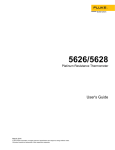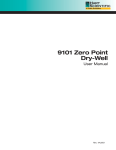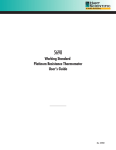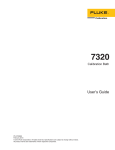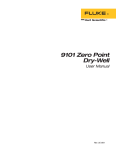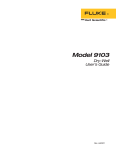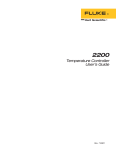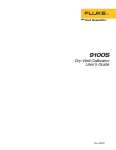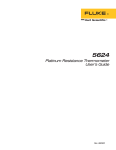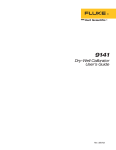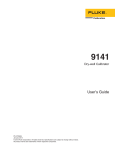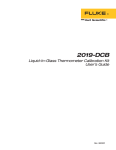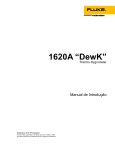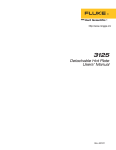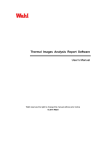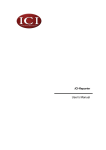Download 9135 User Manual
Transcript
Hart Scientific 9135 Infrared Thermometer Calibrator User’s Guide Rev. 5A2604 Fluke Corporation, Hart Scientific Division 799 E. Utah Valley Drive • American Fork, UT 84003-9775 • USA Phone: +1.801.763.1600 • Telefax: +1.801.763.1010 E-mail: [email protected] www.hartscientific.com Subject to change without notice. • Copyright © 2005 • Printed in USA Rev. 5A2604 Table of Contents 1 Before You Start . . . . . . . . . . . . . . . . . . . . . . . . . . 1 1.1 1.2 Symbols Used . . . . . . . . . . . . . . . . . . . . . . . . . . . . 1 Safety Information . . . . . . . . . . . . . . . . . . . . . . . . . . 2 1.2.1 1.2.2 1.3 Warnings . . . . . . . . . . . . . . . . . . . . . . . . . . . . . . . . . . . . . 2 Cautions . . . . . . . . . . . . . . . . . . . . . . . . . . . . . . . . . . . . . 3 Authorized Service Centers. . . . . . . . . . . . . . . . . . . . . . 3 2 Introduction . . . . . . . . . . . . . . . . . . . . . . . . . . . . 7 3 Specifications and Environmental Conditions . . . . . . . . . . 9 3.1 3.2 Specifications . . . . . . . . . . . . . . . . . . . . . . . . . . . . . 9 Environmental Conditions . . . . . . . . . . . . . . . . . . . . . . 9 3.3 Warranty . . . . . . . . . . . . . . . . . . . . . . . . . . . . . . . 10 4 Quick Start . . . . . . . . . . . . . . . . . . . . . . . . . . . . 11 4.1 4.2 Unpacking . . . . . . . . . . . . . . . . . . . . . . . . . . . . . . 11 Set-up . . . . . . . . . . . . . . . . . . . . . . . . . . . . . . . . 11 4.3 Power . . . . . . . . . . . . . . . . . . . . . . . . . . . . . . . . 11 5 Parts and Controls . . . . . . . . . . . . . . . . . . . . . . . . 13 5.1 Back Panel. . . . . . . . . . . . . . . . . . . . . . . . . . . . . . 13 5.2 5.3 Bottom. . . . . . . . . . . . . . . . . . . . . . . . . . . . . . . . 13 Top Panel . . . . . . . . . . . . . . . . . . . . . . . . . . . . . . 13 5.4 Right Side Panel . . . . . . . . . . . . . . . . . . . . . . . . . . . 14 6 General Operation . . . . . . . . . . . . . . . . . . . . . . . . 17 6.1 6.2 6.3 Set-up . . . . . . . . . . . . . . . . . . . . . . . . . . . . . . . . 17 Setting the Temperature . . . . . . . . . . . . . . . . . . . . . . . 17 Target Ready Indicator . . . . . . . . . . . . . . . . . . . . . . . 17 7 Controller Operation . . . . . . . . . . . . . . . . . . . . . . . 19 8 Thermometer Calibration . . . . . . . . . . . . . . . . . . . . 21 8.1 8.2 IR Thermometer Calibration . . . . . . . . . . . . . . . . . . . . 21 RTD Calibration . . . . . . . . . . . . . . . . . . . . . . . . . . . 21 i 9 Calibration Procedure . . . . . . . . . . . . . . . . . . . . . . 23 10 Maintenance . . . . . . . . . . . . . . . . . . . . . . . . . . . 25 11 Troubleshooting. . . . . . . . . . . . . . . . . . . . . . . . . . 27 11.1 CE Comments . . . . . . . . . . . . . . . . . . . . . . . . . . . . 27 11.1.1 11.1.2 ii EMC Directive . . . . . . . . . . . . . . . . . . . . . . . . . . . . . . . . . 27 Low Voltage Directive (Safety) . . . . . . . . . . . . . . . . . . . . . . . . . 27 1 Before You Start Symbols Used 1 1.1 Before You Start Symbols Used Table 1 lists the International Electrical Symbols. Some or all of these symbols may be used on the instrument or in this manual. Table 1 International Electrical Symbols Symbol Description AC (Alternating Current) AC-DC Battery CE Complies with European Union Directives DC Double Insulated Electric Shock Fuse PE Ground Hot Surface (Burn Hazard) Read the User’s Manual (Important Information) Off On 1 9135 Infrared Thermometer Calibrator User’s Guide Symbol Description Canadian Standards Association OVERVOLTAGE (Installation) CATEGORY II, Pollution Degree 2 per IEC1010-1 refers to the level of Impulse Withstand Voltage protection provided. Equipment of OVERVOLTAGE CATEGORY II is energy-consuming equipment to be supplied from the fixed installation. Examples include household, office, and laboratory appliances. C-TIC Australian EMC Mark The European Waste Electrical and Electronic Equipment (WEEE) Directive (2002/96/EC) mark. 1.2 Safety Information Use this instrument only as specified in this manual. Otherwise, the protection provided by the instrument may be impaired. The following definitions apply to the terms “Warning” and “Caution”. • “Warning” identifies conditions and actions that may pose hazards to the user. • “Caution” identifies conditions and actions that may damage the instrument being used. 1.2.1 Warnings To avoid personal injury, follow these guidelines. • DO NOT operate this unit without a properly grounded, properly polarized power cord. • DO NOT connect this unit to a non-grounded, non-polarized outlet. • DO NOT use this unit for any application other than calibration work. • DO NOT use this unit in environments other than those listed in the user’s guide. • Completely unattended operation is not recommended for safety reasons. • Always replace the fuse with one of the same rating, voltage and type. • If the instrument is used in a manner not in accordance with the equipment design, the operation of the calibrator may be impaired or safety hazards may arise. • Follow all safety guidelines listed in the user’s manual. • DO NOT operate near flammable materials. • DO NOT use fluids to clean the plate. 2 1 Before You Start Authorized Service Centers • The instrument can generate high temperatures. Precautions must be taken to prevent personal injury or damage to objects. Probes may be very hot when removed from the instrument. Cautiously handle probes to prevent personal injury. Carefully place probes on a heat resistant surface or rack until they are at room temperature. Never place any objects other than the probe to be calibrated into the plate. • Calibration Equipment should only be used by Trained Personnel. 1.2.2 Cautions To avoid possible damage to the instrument, follow these guidelines. • Never introduce fluids or any foreign material onto the IR target or into the well block. • DO NOT change the values of the calibration constants from the factory set values. The correct setting of these parameters is important to the safety and proper operation of the calibrator. • ONLY OPERATE this unit with proper supply voltage and frequency. Make sure both of the voltage switches are set properly. Operating this instrument with the wrong supply voltage or switch settings can damage the instrument and has the potential to start a fire. • Operate the instrument in room temperatures between 5-40°C (41-104°F). Allow sufficient air circulation by leaving at least three inches of space between the instrument and nearby objects. • This is a precision instrument. Although it has been designed for optimum durability and trouble free operation, it must be handled with care. The instrument should not be operated in excessively wet, oily, dusty, or dirty environments. It is important to keep the plate of the instrument clean and clear of any foreign matter. • If a mains supply power fluctuation occurs, immediately turn off the instrument. Severe power disturbances from brownouts and blackouts could damage the instrument. Wait until the power has stabilized before re-energizing the instrument. • The calibrator is equipped with an internal electrical fuse. If a fuse blows, it is likely caused by failure of another part. If this occurs, the calibrator should be returned for inspection. Contact a Hart Scientific Authorized Service Center for assistance. 1.3 Authorized Service Centers Please contact one of the following authorized Service Centers to coordinate service on your Hart product: Fluke Corporation, Hart Scientific Division 799 E. Utah Valley Drive 3 9135 Infrared Thermometer Calibrator User’s Guide American Fork, UT 84003-9775 USA Phone: +1.801.763.1600 Telefax: +1.801.763.1010 E-mail: [email protected] Fluke Nederland B.V. Customer Support Services Science Park Eindhoven 5108 5692 EC Son NETHERLANDS Phone: +31-402-675300 Telefax: +31-402-675321 E-mail: [email protected] Fluke Int'l Corporation Service Center - Instrimpex Room 2301 Sciteck Tower 22 Jianguomenwai Dajie Chao Yang District Beijing 100004, PRC CHINA Phone: +86-10-6-512-3436 Telefax: +86-10-6-512-3437 E-mail: [email protected] Fluke South East Asia Pte Ltd. Fluke ASEAN Regional Office Service Center 60 Alexandra Terrace #03-16 The Comtech (Lobby D) 118502 SINGAPORE Phone: +65 6799-5588 4 1 Before You Start Authorized Service Centers Telefax: +65 6799-5588 E-mail: [email protected] When contacting these Service Centers for support, please have the following information available: • Model Number • Serial Number • Voltage • Complete description of the problem 5 2 Introduction 2 Introduction Hart Scientific’s Model 9135 Infrared Thermometer Calibrator is a small, portable instrument designed for quick on-site checks and calibration of infrared thermometers. It features an aluminum temperature-controlled plate coated with special 0.95 emmisivity paint. A precision proportional-integral temperature controller maintains the temperature of the plate. The set-point can be conveniently selected by the one-button control to 50°C, 100°C, or 150°C. One of three yellow LEDs corresponding to the three set-points glows to indicate which set-point is selected. A green LED turns on when the temperature of the plate reaches the set-point temperature and is stable. The 9135 calibrator was designed for portability, low cost, speed, and ease of operation. 7 3 Specifications and Environmental Conditions Specifications 3 Specifications and Environmental Conditions 3.1 3.2 Specifications Set-points 50°C (122°F), 100°C (212°F), and 150°C (302°F) Accuracy ±1.0°C Stability (2-sigma) ±0.1°C (±0.18°F) Target Emmisivity 0.95 Target Area 1.5 in. (38 mm) diameter Test Well Size 0.125 in. (3.18 mm) diameter Heating Time 25 to 150°C: 3 minutes typical Stabilization Time 3 minutes typical Cooling Time 150 to 50°C: 25 minutes typical Power 115 VAC (±10%), 1.0 A, or 230 VAC (±10%), 0.5 A, 50/60 Hz, 125 W. Size 1.8" (46 mm) H x 4.4" (112 mm) W x 7.8" (198 mm) D Weight 1.5 lb. (0.7 kg) Safety OVERVOLTAGE (Installation) CATEGORY II, Pollution Degree 2 per IEC1010-1 Environmental Conditions Although the instrument has been designed for optimum durability and trouble-free operation, it must be handled with care. The instrument should not be operated in an excessively dusty or dirty environment. Maintenance and cleaning recommendations can be found in the Maintenance section of this manual. The instrument operates safely under the following conditions: • temperature range: 5-40°C (41-104°F) • ambient relative humidity: maximum 80% for temperature <31°C, decreasing linearly to 50% at 40°C • pressure: 75kPa-106kPa • mains voltage within ±10% of nominal • vibrations in the calibration environment should be minimized • altitude less than 2,000 meters 9 9135 Infrared Thermometer Calibrator User’s Guide 3.3 Warranty Fluke Corporation, Hart Scientific Division (Hart) warrants this product to be free from defects in material and workmanship under normal use and service for a period as stated in our current product catalog from the date of shipment. This warranty extends only to the original purchaser and shall not apply to any product which, in Hart’s sole opinion, has been subject to misuse, alteration, abuse or abnormal conditions of operation or handling. To exercise this warranty, the purchaser must forward the product after calling or writing a Hart Scientific Authorized Service Center (see Section 1.3) for authorization. The Service Centers assume NO risk for in-transit damage. THE FOREGOING WARRANTY IS PURCHASER’S SOLE AND EXCLUSIVE REMEDY AND IS IN LIEU OF ALL OTHER WARRANTIES, EXPRESS OR IMPLIED, INCLUDING BUT NOT LIMITED TO ANY IMPLIED WARRANTY OR MERCHANTABILITY, OR FITNESS FOR ANY PARTICULAR PURPOSE OR USE. HART SHALL NOT BE LIABLE FOR ANY SPECIAL, INDIRECT, INCIDENTAL, OR CONSEQUENTIAL DAMAGES OR LOSS WHETHER IN CONTRACT, TORT, OR OTHERWISE. 10 4 Quick Start Unpacking 4 4.1 Quick Start Unpacking Unpack the calibrator carefully and inspect it for any damage that may have occurred during shipment. If there is shipping damage, notify the carrier immediately. Verify that the following components are present: • 9135 Calibrator • Manual • Report of Calibration • Calibration Label 4.2 Set-up Place the calibrator on a flat surface with at least three inches of free space around the instrument. The prop may be swung down to tilt the instrument from a horizontal position. Plug the power cord into a grounded mains outlet of the proper voltage (see Section 4.3). Observe that the nominal voltage corresponds to that indicated on the back of the calibrator. Turn on the power to the calibrator by toggling the power switch on. The yellow LED corresponding to the 50°C set-point should immediately illuminate and the calibrator should begin heating to 50°C. If the unit fails to operate please check the power connection. 4.3 Power The calibrator is configured for either 115 VAC (±10%), 50/60 Hz or 230 VAC (±10%), 50/60 Hz using switches underneath. There are two switches and both must be set to the correct voltage. One switch configures the power supply and the other configures the heater. The calibrator can be switched in the field for operation at either voltage as long as the following conditions are observed: • The supply voltage must always match the switch settings! Operating this instrument with the wrong supply voltage or switch settings will likely damage the instrument and has the potential to start a fire. • Both voltage switches must be set properly. Again, operating this instrument with the wrong supply voltage or switch settings will likely damage the instrument and has the potential to start a fire. • Always unplug the instrument before changing the voltage settings! Changing the voltage switches with power applied will likely damage the instrument and has the potential to start a fire. Use a small slotted-type screwdriver or equivalent instrument to change the switches. 11 9135 Infrared Thermometer Calibrator User’s Guide The mains supply must be reasonably stable and free from surges, dropouts, and interference that can affect the temperature stability of the IR target. 12 5 Parts and Controls Back Panel 5 Parts and Controls The user should become familiar with the 9135 calibrator and its parts. Refer to Figures 1 and 2 as you read the following sections. 5.1 Back Panel Power Cord - The power cord attaches to the back of the instrument. It plugs into a standard 115 VAC (optional 230 VAC) grounded socket. Power Switch - The power switch is located on the back panel of the calibrator. The switch is either on or off. The on position is for normal operation. The off position disconnects power to the entire unit. 5.2 Bottom Prop - The prop is located on the bottom of the 9135 and lays flat against the bottom of the calibrator when not in use. It can be swung down to incline the instrument. Supply Voltage Switches - These switches are set to 115V or 230V depending on the supply voltage (Section 4.3). 5.3 Top Panel The top panel is illustrated in Figure 1. IR Target - The large hole in the top panel gives access to the IR target. The IR target is a metal plate that is coated with a special paint with an emmisivity of 0.95. The IR target is controlled at the selected set-point. Set-point Select - The button on the top panel is used to select one of the three set-points. Pressing the button selects the next set-point in the order 50°C-100°C-150°C then back to 50°C. The LED corresponding to the selected set-point will light. Set-point Indicators - The three yellow LEDs on the top panel correspond to the three set-points. When the power is on one LED will glow indicating which set-point is currently selected. Target Ready Indicator - The green LED shows when the temperature of the IR target is reached and is stable. Immediately after the power is switched on or a new set-point is selected the ready indicator will be dark. It will light up when the temperature has stabilized at the set-point. This indicates the instrument is now ready to be used for calibration. 13 9135 Infrared Thermometer Calibrator User’s Guide Power Cord Socket Power Switch INFRARED CALIBRATOR : HOT SUR ION FA UT RFACE SU SU OT :H UTION: HO CA T ACE CAUTIO RF N Target Ready Indicator IR Target CE CA 9135 150°C 302°F TARGET READY 100°C 212°F Set-point Indicators 50°C 122°F Set-point Select SET-POINT SELECT Figure 1 Top Panel 5.4 Right Side Panel The right side panel is illustrated in Figure 2. Test Well - The right side panel has a 6.3 mm (0.25") hole near its center that allows access to a 3.18 mm (0.125") test well in the IR target plate. The test well accepts 3.18 mm (0.125") RTDs, thermistor probes, or thermocouples for calibration (see Section 8.2). The test well is also used to calibrate the 9135 against a standard RTD (see Section 9). Calibration Access Hole - There is a small oblong hole on the right side panel. These gives access to two potentiometers used to calibrate the 9135. DO NOT 14 5 Parts and Controls Right Side Panel adjust these potentiometers unless qualified to do so as part of a regular maintenance and calibration schedule (see Section 9). Calibration Access Hole Test Well Prop Figure 2 Right Side Panel 15 6 General Operation Set-up 6 General Operation This section explains basic operation of the 9135 calibrator. 6.1 Set-up Place the calibrator on a flat surface with at least three inches of free space around the instrument. The prop may be swung down to tilt the instrument from a horizontal position. Plug the power cord into a grounded mains outlet. Make sure the supply voltage and voltage switch settings are correct (see Section 4.3). The supply voltage must always match the switch settings! Operating this instrument with the wrong supply voltage or switch settings will likely damage the instrument and has the potential to start a fire. Turn on the power to the calibrator by toggling the power switch on. The yellow LED corresponding to the 50°C set-point should immediately illuminate and the calibrator will begin heating to this set-point. If the unit fails to operate please check the power connection. The green ready LED should initially be dark until the IR target reaches the set-point. 6.2 Setting the Temperature As soon as the 9135 calibrator is switched on, the 50°C set-point LED lights and the instrument begins to heat to 50°C. If this set-point is desired, wait until the temperature stabilizes. To select the 100°C set-point press the select button once and observe the 100°C set-point LED light up. To select the 150°C set-point press the select button once more and observe the 150°C set-point LED light up. To set the set-point back to 50°C press the select button once or twice until the 50°C set-point LED lights up. Any time the select button is pressed the green ready LED will go dark and stay dark until the temperature reaches the new set-point. After the set-point is selected it will take some time for the instrument to heat or cool to the desired temperature. Wait for the green ready indicator to light up before proceeding with any calibrations. 6.3 Target Ready Indicator The green target ready indicator shows when the IR target has stabilized to the set-point. Immediately after the power is switched on and any time the select button is pressed to change the set-point, the green LED will go dark and stay dark until the temperature reaches the new set-point. After setting the set-point it can take up to ten minutes to heat up to and stabilize at a higher temperature and up to 40 minutes to cool down to and to stabilize at a lower temperature. When the set-point is reached and the temperature becomes stable the green ready LED will light indicating that the target is ready for calibration. 17 7 Controller Operation 7 Controller Operation The 9135 calibrator uses a precise analog proportional-integral controller that maintains the temperature of the IR target. The set-point is controlled by a special digital switching circuit that allows one button to advance through the sequence of set-points. It also contains a power on reset circuit that causes the controller to default to the first set-point immediately after the power is switched on. The controller senses the temperature of the IR target using a thermistor sensor imbedded in the plate. It compares the resistance of the thermistor to preset set-point resistances to determine whether the IR target should be heated or cooled and how much power should be applied. The controller uses a solid-state relay circuit to apply power in a time-proportioned manner to a resistance heater attached to the IR target. The ready indicator circuit uses the difference signal between the temperature sensor and the set-point to determine whether temperature stability has been achieved or not and switches the ready LED on or off accordingly. 19 8 Thermometer Calibration IR Thermometer Calibration 8 Thermometer Calibration The 9135 calibrator was designed primarily for calibrating infrared thermometers. However, it can also be used to calibrate certain types of RTDs. The following sections explain the calibration of IR thermometers and RTDs respectively. 8.1 IR Thermometer Calibration Infrared thermometers are calibrated by pointing them at the 9135’s IR target and comparing their readings to the known temperature of the target. In order to achieve accurate measurements several important conditions must be observed: • The IR target must first reach the desired temperature and be stable. The green ready LED lights up when the IR target is ready for calibration. DO NOT attempt to calibrate thermometers unless the green ready LED is lit, otherwise accuracy may be compromised. • The 9135’s IR target is specially coated for an emmisivity of 0.95. The 9135 should only be used to calibrate IR thermometers that are set for this value of emmisivity. DO NOT attempt to calibrate thermometers unless they are set for 0.95 emmisivity, otherwise accuracy may be compromised. • When calibrating IR thermometers the thermometer must “see” only the IR target of the 9135. The thermometer must be pointed directly at the target at approximately a 90° angle and with a close enough proximity that the target area of the thermometer is completely contained within the IR target of the 9135. This may depend on the particular IR thermometer being used. DO NOT attempt to calibrate a thermometer unless it is close enough to ensure that its target area falls entirely within the IR target of the 9135, otherwise accuracy may be compromised. • Remember that the IR target gets hot! Be careful not to touch the IR target or let any object come into contact with it. The IR target must be kept clean (see Section 10). 8.2 RTD Calibration The IR target plate of the 9135 has a 3.18 mm. (0.125") hole in it that can be used to calibrate appropriately sized RTDs as well as thermistors and thermocouples. Access to the well is through a 6.3 mm. (0.25") hole near the center of the right side panel. Please observe the following points when calibrating RTDs and other probes: • The IR target plate must first reach the desired temperature and be stable. The green ready LED lights up when the IR target plate is ready for cali- 21 9135 Infrared Thermometer Calibrator User’s Guide bration. DO NOT attempt to calibrate thermometers unless the green ready LED is lit, otherwise accuracy may be compromised. • The 9135’s test well is intended for 3.18 mm. (0.125") diameter probes only. DO NOT attempt to force probes larger than this size or bent probes into the well. For good accuracy the probe must be inserted the full depth of the well and not fit too loosely. DO NOT attempt to calibrate thermometers that are too short or too loose, otherwise accuracy may be compromised. • The test well must be kept clean and dry. Dirt, oil, or objects stuck in the well can affect the safety and operation of the 9135 and especially affect the ability to calibrate the instrument in the future. DO NOT attempt to insert fluid, grease, or any objects other than clean thermometers into the well. • Inserting a probe into the test well may temporarily disturb the temperature of the target plate. For best results wait at least three minutes after inserting the probe before continuing with the calibration. • Remember that the IR target gets hot! Be careful not to touch the IR target or let any object other than the probe being calibrated to come into contact with it. Probes removed from the test well can be hot and remain so for several minutes. After removing a probe, place it on a safe heat-resistant surface or holder until it cools down. 22 9 Calibration Procedure 9 Calibration Procedure The 9135 should be calibrated regularly to ensure accuracy. A one-year or less calibration interval is recommended. Calibration should only be performed by a qualified and authorized technician. The calibration of the 9135 entails adjusting the calibration potentiometers inside the instrument until the temperature of the IR target is close to the set-point temperature as observed with a calibrated standard RTD at each of the three set-points. The following are required: • Standard calibrated RTD or thermistor, 3.18 mm (0.125") diameter and at least 100 mm (4") sheath length, and a readout device, total uncertainty 0.2°C or better • Potentiometer adjustment tool The calibration procedure is as follows: 1. Insert the standard RTD or thermistor fully into the test well of the 9135 through the test well access hole in the right panel. 2. Set the set-point to 50°C and let it stabilize. Wait for the green ready LED to light. 3. Adjust the potentiometer on the right one-half turn at a time, waiting one to two minutes between adjustments, until the standard RTD or thermistor shows the temperature is close to 50°C within 0.2°C. Adjust the potentiometer clockwise to increase the temperature or counter-clockwise to decrease the temperature. 4. Set the set-point to 150°C and let it stabilize. Wait for the green ready LED to light. 5. Adjust the potentiometer on the left one-half turn at a time, waiting one to two minutes between adjustments, until the standard RTD or thermistor shows the temperature is close to 150°C within 0.2°C. Adjust the potentiometer clockwise to increase the temperature or counter-clockwise to decrease the temperature. 6. Set the set-point to 100°C and let it stabilize. Wait for the green ready LED to light. 7. If the standard RTD or thermistor shows the temperature differs from 100°C by more than 0.5°C but less than 1°C then adjust the potentiometer on the right one-half turn at a time, waiting one to two minutes between adjustments, until the standard RTD or thermistor shows the temperature is close to 100°C within 0.25 to 0.5°C. Do not force the temperature to exactly 100°C or the error at the other two set-points will be excessive. If the temperature differs from 100°C by more than 1°C then the instrument may require factory service. 8. Check the temperature once more at each of the three set-points. 23 10 Maintenance 10 Maintenance • This calibration instrument has been designed for a minimum of required maintenance as long as it is handled with proper care. Please regard the following: • Avoid operating the instrument in an oily, wet, dirty, or dusty environment. If the outside of the instrument becomes soiled, it may be wiped clean with a damp cloth and mild detergent. DO NOT use harsh chemicals on the surface which may damage the paint. • It is very important to keep the IR target clean. Avoid allowing any objects to contact the surface of the IR target that may contaminate or scratch it. DO NOT use fluid to clean the IR target. Dust can be blown off with clean air. When not in use it is advisable to store the calibrator in a clean covered container. • The test well must be kept clean and dry. Dirt, oil, or objects stuck in the well can affect the safety and operation of the 9135 and especially affect the ability to calibrate the instrument in the future. DO NOT attempt to insert fluid, grease, or any objects other than clean thermometers into the well. DO NOT use fluid to clean out the well. • The calibrator should be handled with care. Avoid knocking, bumping, or dropping the calibrator. Due to the size and portability of the 9135, it is vulnerable to being shocked and dropped as it is carried around. It might be inadvertently dragged off a table top while in use. This can cause permanent damage to the instrument and loss of accuracy. • If a hazardous material is spilt on or inside the equipment, the user is responsible for taking the appropriate decontamination steps as outlined by the national safety council with respect to the material. • If the mains supply cord becomes damaged, replace it immediately. • Before using any cleaning or decontamination method except those recommended by Hart, users should check with a Hart Scientific Authorized Service Center to be sure that the proposed method will not damage the instrument. • If the instrument is used in a manner not in accordance with the equipment design, the operation of the dry-well may be impaired or safety hazards may arise. • The 9135 calibrator is calibrated at the factory for optimum performance. Field adjustment to the instrument should not be attempted. If the unit is suspected to be out of calibration or in need of repair, please contact the factory for assistance. The unit should be recalibrated at the factory yearly. Never attempt to modify the instrument. 25 9135 Infrared Thermometer Calibrator User’s Guide WARNING: Never introduce any fluids or other foreign material onto the IR target or into the well block. This will damage the calibrator, cause loss of accuracy, and may cause sticking and damage to your probes. In the event that the calibrator should require service or repair, please contact a Hart Scientific Authorized Service Center for assistance. The user should not attempt to make any repairs or adjustments. 26 11 Troubleshooting CE Comments 11 Troubleshooting If problems arise while operating the 9135, this section provides some suggestions that may help you solve the problem. If, after considering the following suggestions, the problem still cannot be resolved, call an Authorized Service Center for assistance. Opening the unit without contacting an Authorized Service Center may void the warranty. Problem Causes and Solutions Incorrect temperature reading Check that the green ready LED is lit showing that the IR target has stabilized to the set-point. Check that the IR thermometer is close enough to the IR target. Check that the IR thermometer is set to 0.95 emmisivity. Check that the IR target surface is clean and free of particles. Check the temperature with a calibrated 3.18 mm. (0.125") diameter RTD to verify the temperature of the IR target. Have the instrument calibrated regularly. None of the LEDs light Check that the power cord is plugged in and the power switch is on. Check that the mains supply is the correct voltage as indicated on the back of the calibrator. The internal fuse may be blown or the calibrator may be damaged in which case the instrument should be returned. Contact a Hart Scientific Authorized Service Center for assistance. The ready indicator stays dark Even under normal circumstances it can take up to ten minutes to heat up to and stabilize at a higher temperature and up to 40 minutes to cool down to and stabilize at a lower temperature. Check that the mains supply is the correct voltage as indicated on the back of the calibrator. Make sure the mains supply is reasonably free from surges, drop-outs, and interference. 11.1 CE Comments 11.1.1 EMC Directive Hart Scientific’s equipment has been tested to meet the European Electromagnetic Compatibility Directive (EMC Directive, 89/336/EEC). The Declaration of Conformity for your instrument lists the specific standards to which the unit was tested. 11.1.2 Low Voltage Directive (Safety) In order to comply with the European Low Voltage Directive (73/23/EEC), Hart Scientific equipment has been designed to meet the IEC 1010-1 (EN 61010-1) and IEC 1010-2-010 (EN 61010-2-010) standards. 27


























